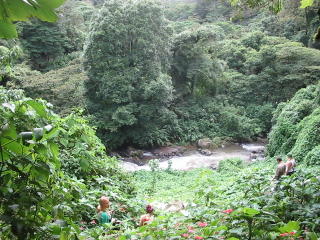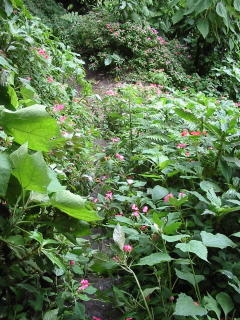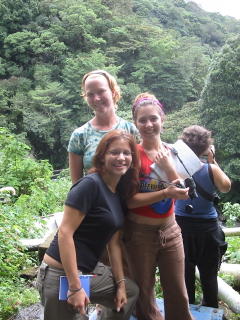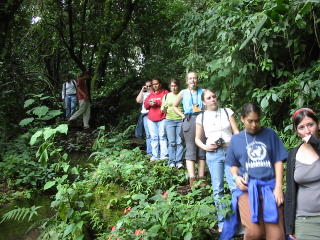From Naciente Poas





For two days we have been travelling to more rural areas of the country studying Costa Rican participation in the global market (characterized by agriculture production), and the environmental consequences of this participation. These are pictures I took yesterday. I am sure you all are admiring the lush, green scenary. What a vibrant looking ecosystem, right? Unfortunately looks can deceive, and in this case they do. On this hike we were headed down to the point of emersion of a natural spring, that is located down the hill from a large fern plantation. Ferns, which are a huge crop for export for the use of filler for flower bouquets in the United States and Europe, bring riches to the large farmers of the area and contribute to the contamination of the water source that provides drinking water to a large population living in the central valley. The agro-chemicals, sprayed onto the ferns to keep them 'healthy' end up in the watershed, and eventually in our bodies. As we learned the day before, this is not a phenomenon unique to ferns, the production of all of the crops for export, including coffee, bananas and pineapples, contribute to the contamination of water sources throughout the country. Many people will claim they are taking environmental precautions, but it is obvious that business is the most important consideration.
Over two days we visited a Dole banana plantation, a fairtrade coffee cooperative, a fern farm, and spoke with some people working with environmental NGOs. Through this experience I have learned a lot about the human and environmental costs of Costa Rica's participation in the global market. On many of these farms, they use (or have used) chemicals that are illegal in the United States, which have caused sterilization in thousands of workers, as well as mutations in children. To my surprise, we also learned that Costa Rica has the highest occurence of gastro-intestinal cancer in the world, which leads me to suspect that the chemicals ingested by way of food and water are the main culprits. It is difficlut for me to look at bananas and flower bouquets in the same way. Of course when picking out a beautiful bouquet, I never consider that the fern in the background has contributed to the destruction of ecosystems, or that for me to put banana on my cereal, some poor fellow has sacrificed his ability to have a family.
These things are difficult to take in, because we are now so tied to the world market, that it is almost impossible not to support these activities. However, we also started learning about the important role that the consumer plays. The philosophy of the production of these crops is "more for less", by using agro-chemicals they maximize and push production, that they then sell for a very low price. This results in environmental degradation, as well as human degredation. Not only are people vulnerable to health effects, they are also not paid a fair or often even a living wage. With the fall of the market price for coffee in recent years, the price per pound has been as low as $.48, while the cost of production is $.75/lb. This is not a savings that we see in the supermarket, and yet thousands of coffee-farmers are living in destitute conditions due to an unfair market.
How is this even possible? How does a system persist in which many producers are making back only half of what it costs to produce? How can we even still question why developing countries cannot pull themselves out of poverty, and in some cases become more impoverished? We as part of the group of consumers must become informed. In the long-run this is a system that is obviously not sustainable, and we must participate in the change. Part of the answer to this dire situation is buying products that have been fairly traded. We visited Coopesarapiqui, which is a part of the much larger Coocafe. Coopesarapiqui has a membership of over 200 small farmers, who bring their harvested coffee to the larger processing plant. Through the fairtrade coop, farmers are guaranteed a constant minimum price of $1.26/lb. no matter the fluctuation of the regular market. To me this still seems like a piddling amount, and yet it is enough for them to sustain their livlihoods, and it offers stability that the regular market does not. I came to the realization that this is a difference that I as a consumer can afford, but they as producers cannot. To me it is a question of priorities and small sacrifices, to them it is a question of survival. I encourage everyone to reflect upon this seriously, and choose to exercize your power as a consumer. As a response to the increasing momentum of the fairtrade movement, more and more farmers and coops are trying to participate. Not surprisingly, the fairtrade and organic movements seem to go hand-in-hand. Many consumers interested in fairtrade are also interested in organic products, thus many of the farms and coops are also making the transition to organic production. This is one of the keys to solving a huge problem, and we can participate in the change.


1 Comments:
Thanks, Eva. I will go and ask them at Vic's, and any other place I buy coffee, "Is it fair trade?" Isolde
Post a Comment
<< Home